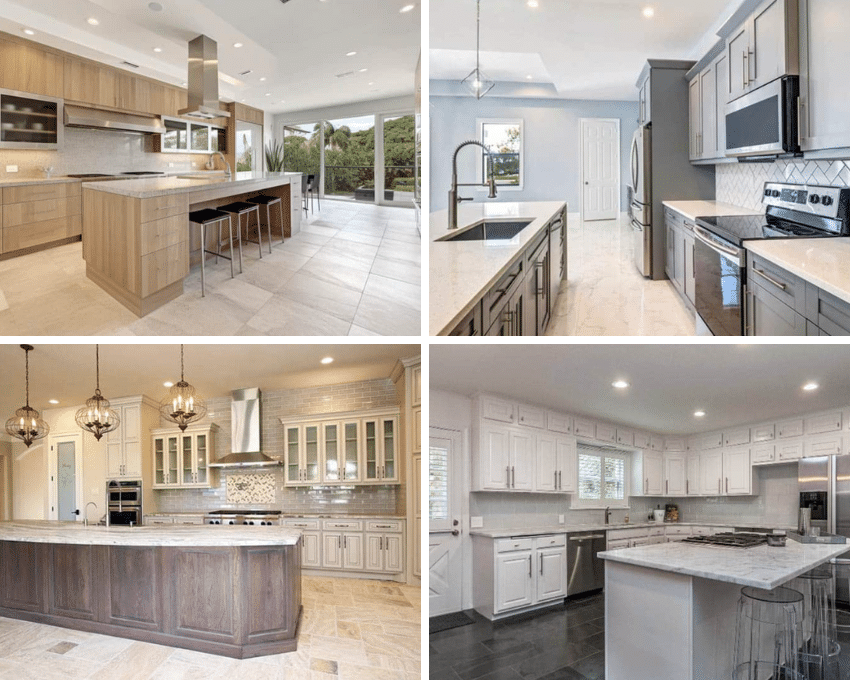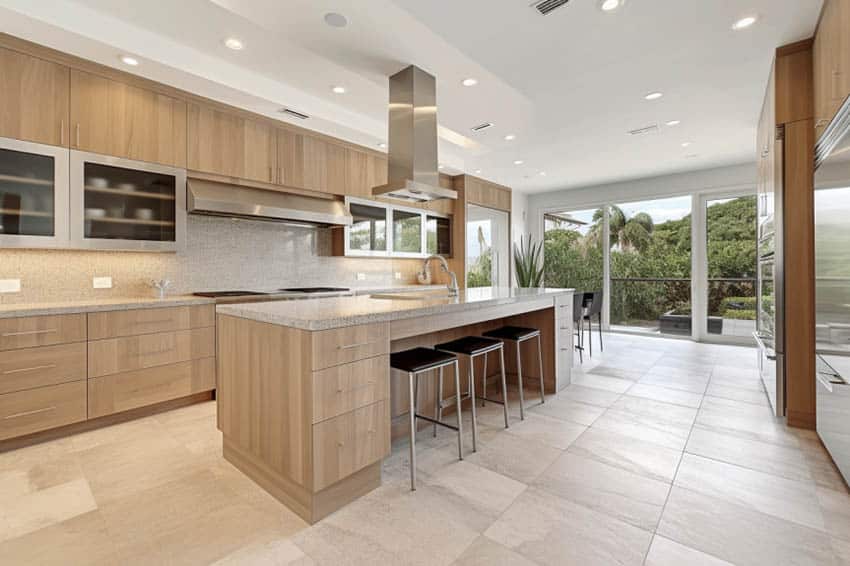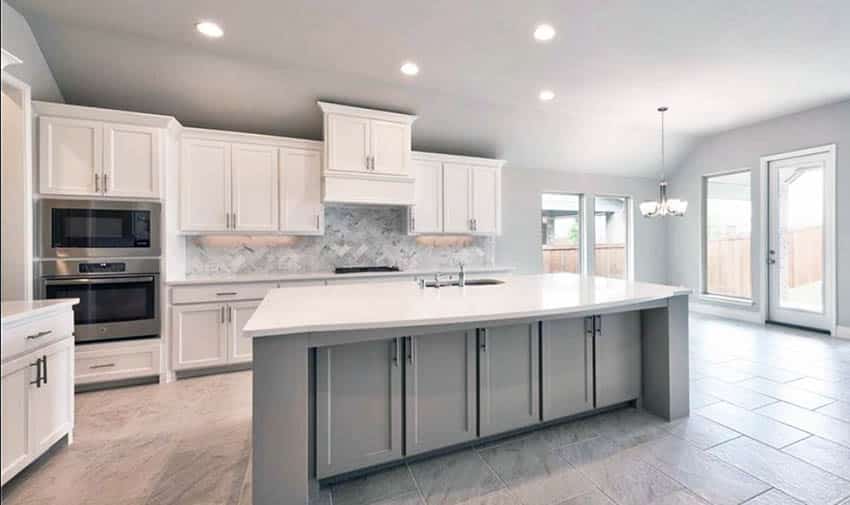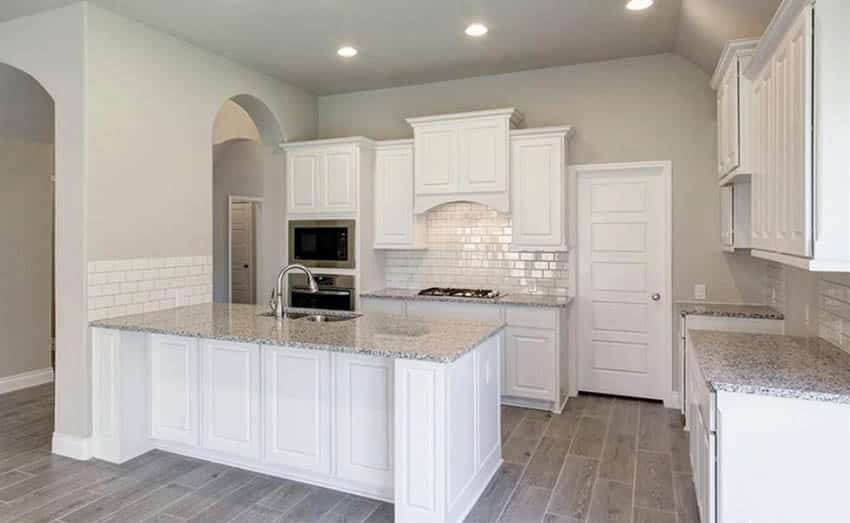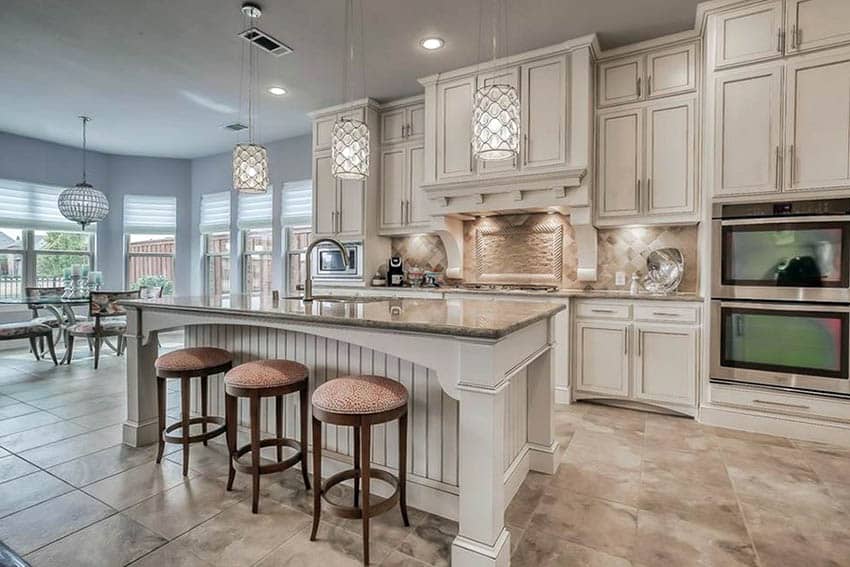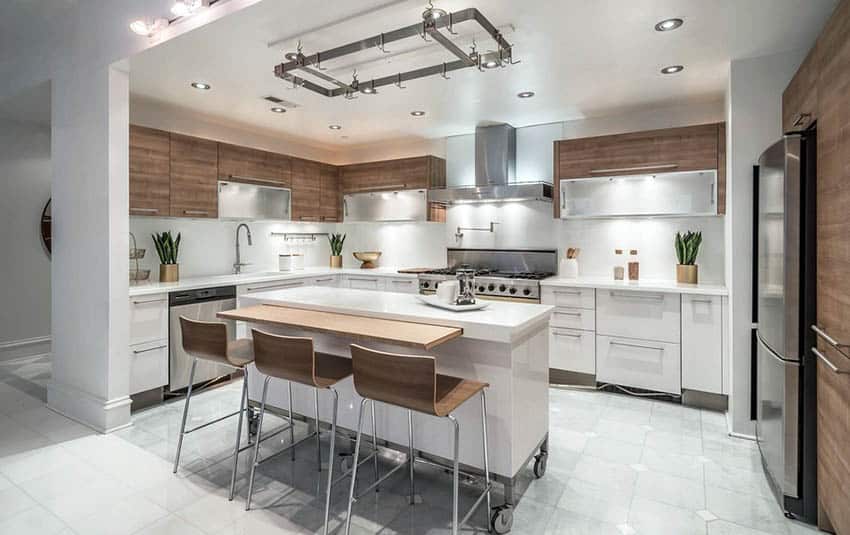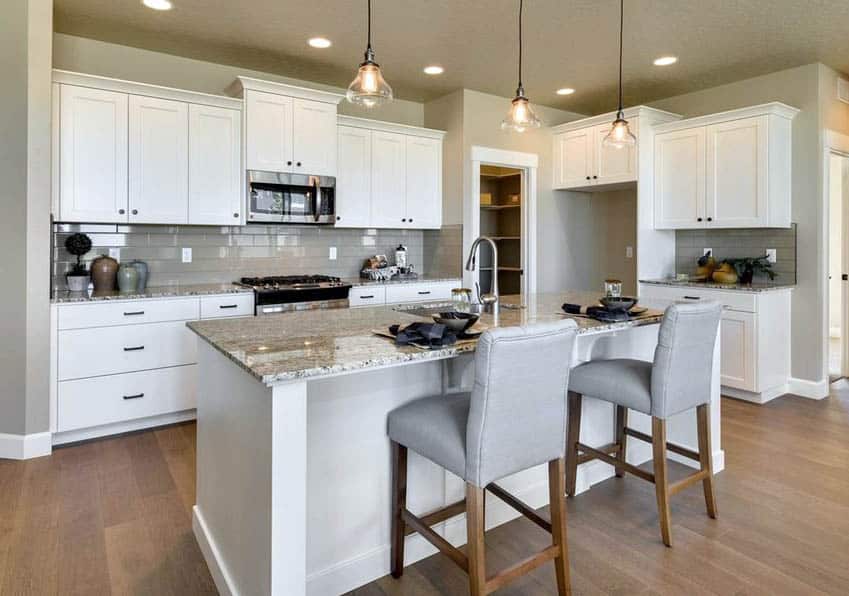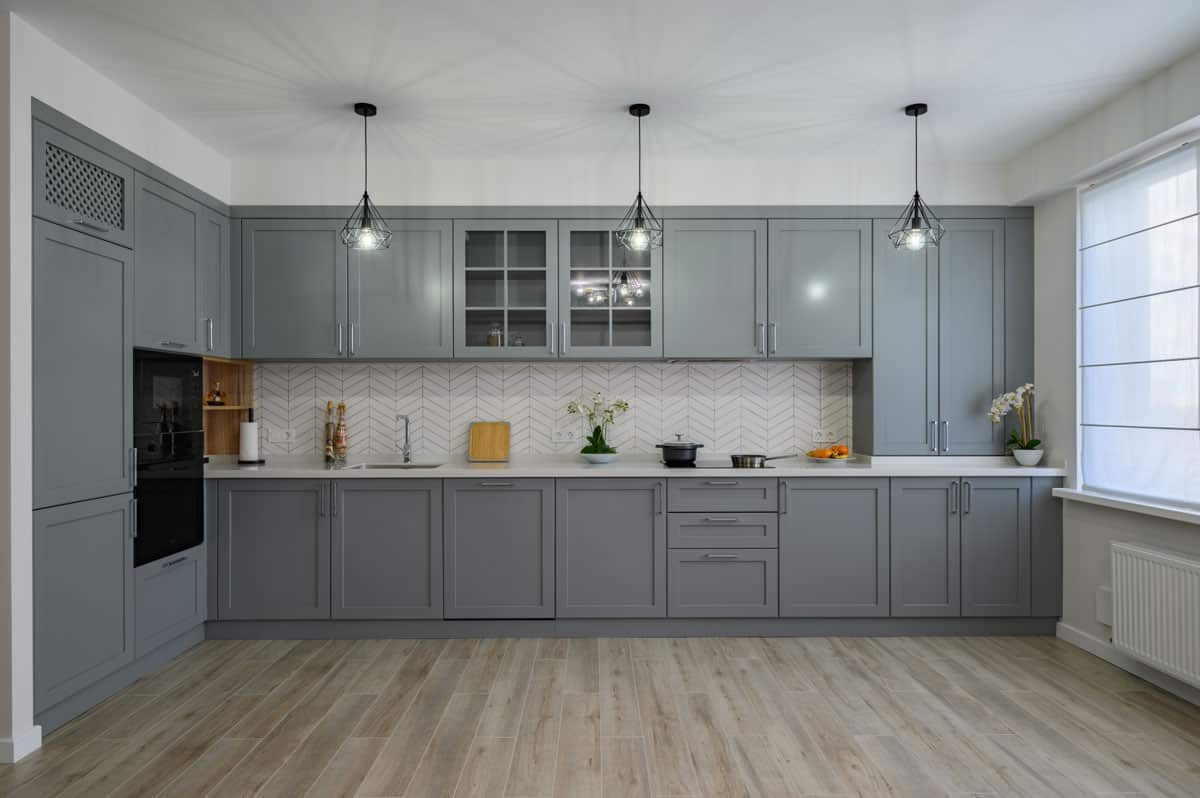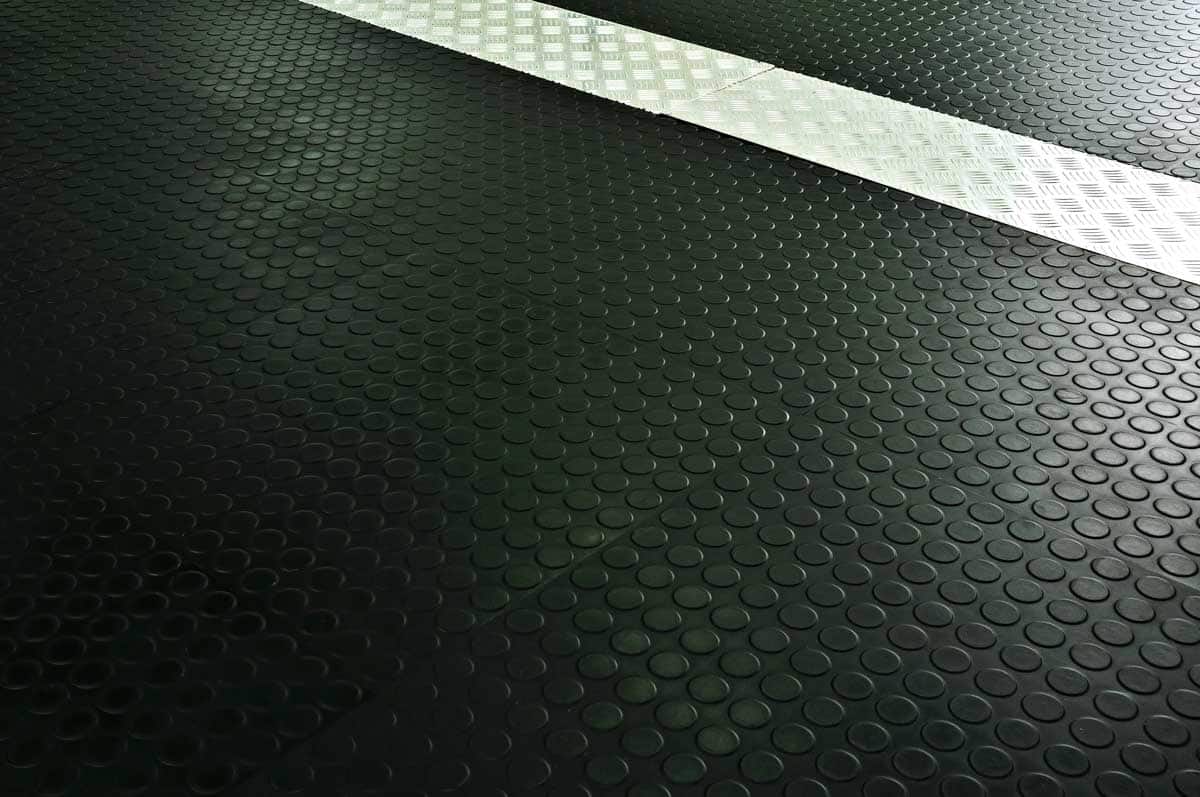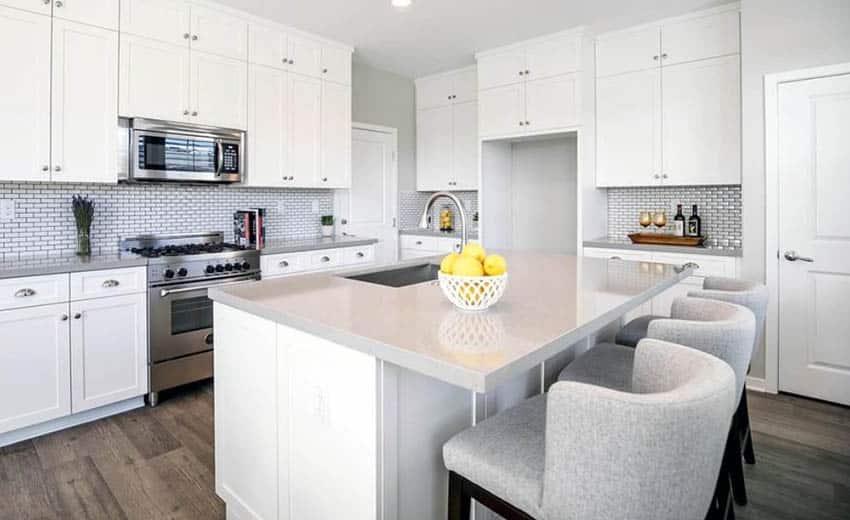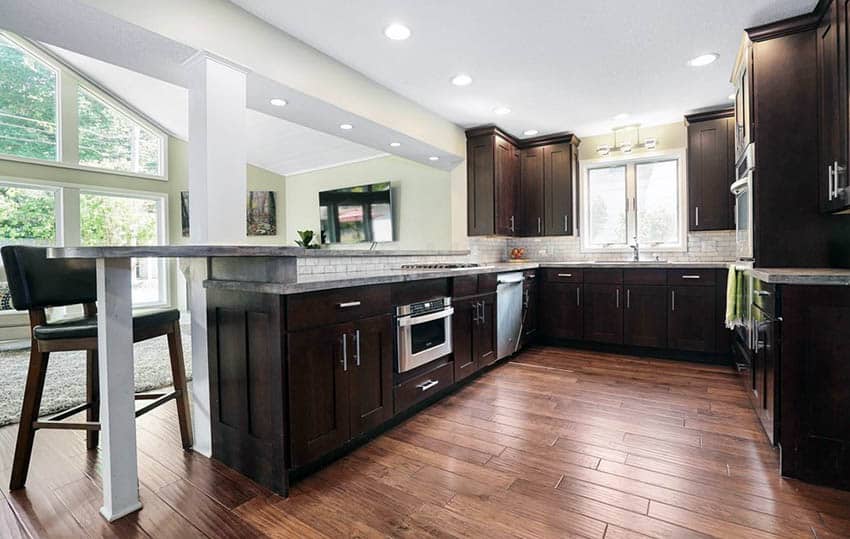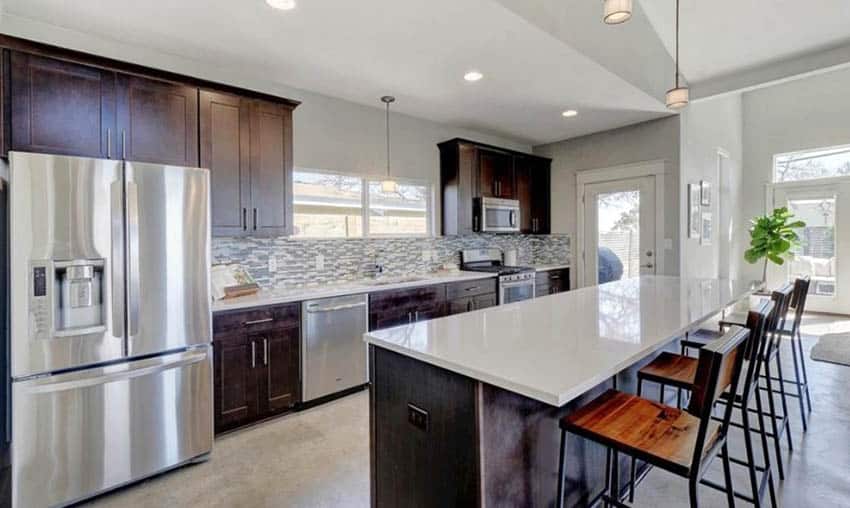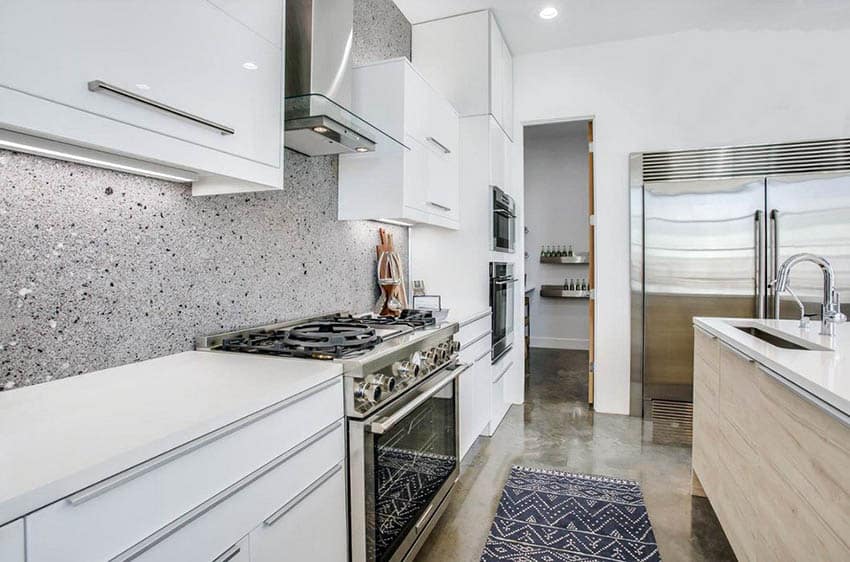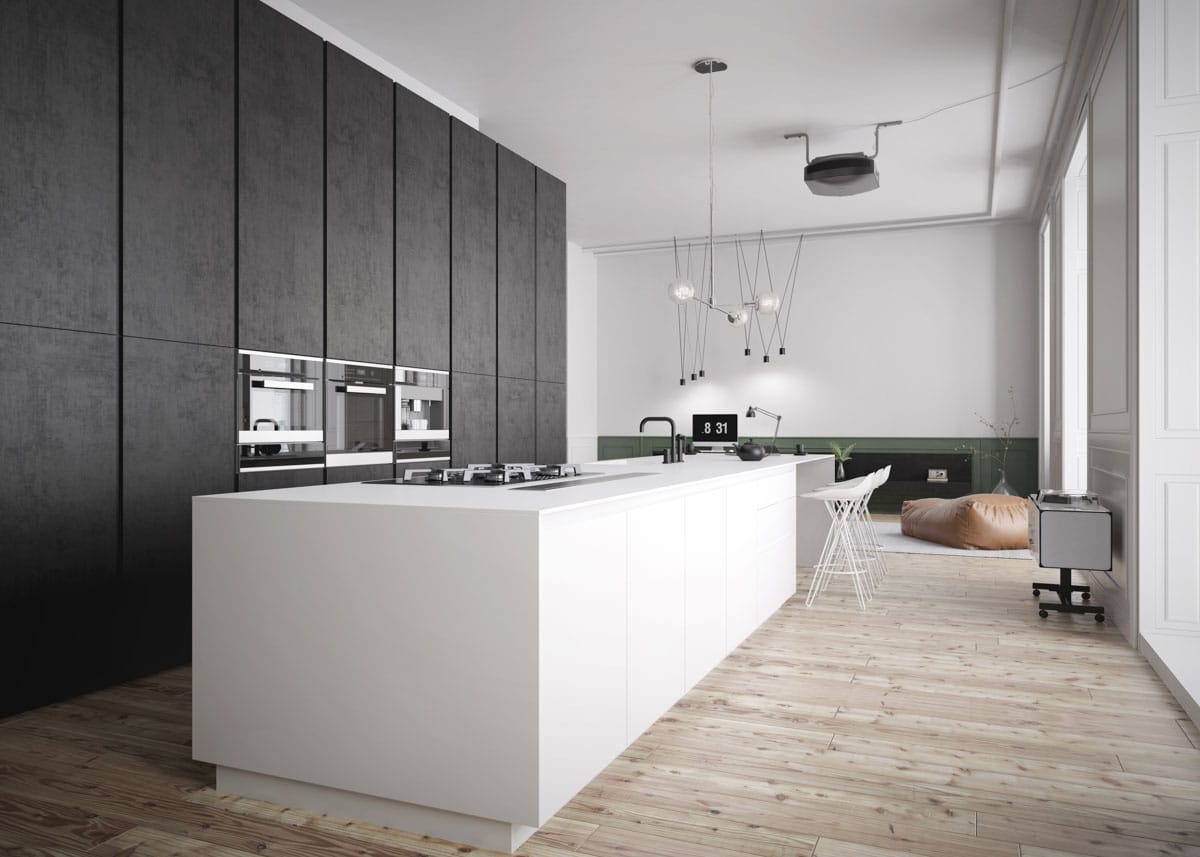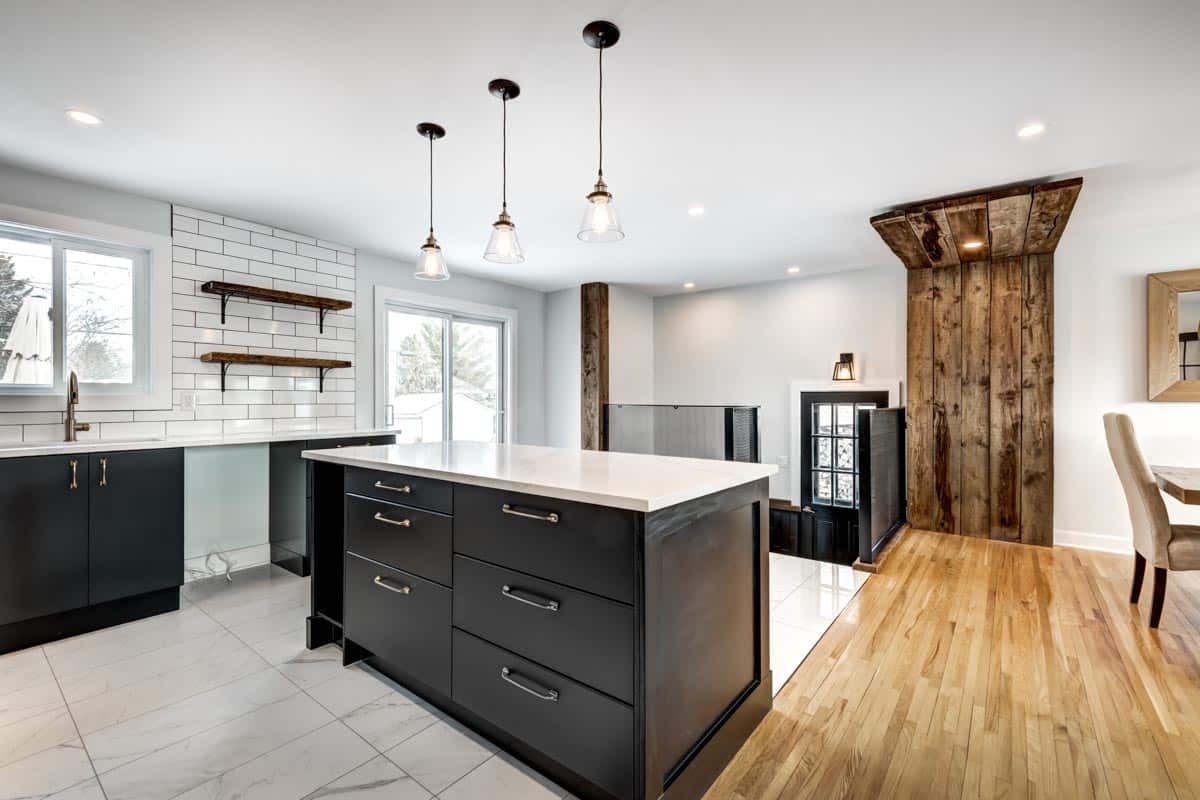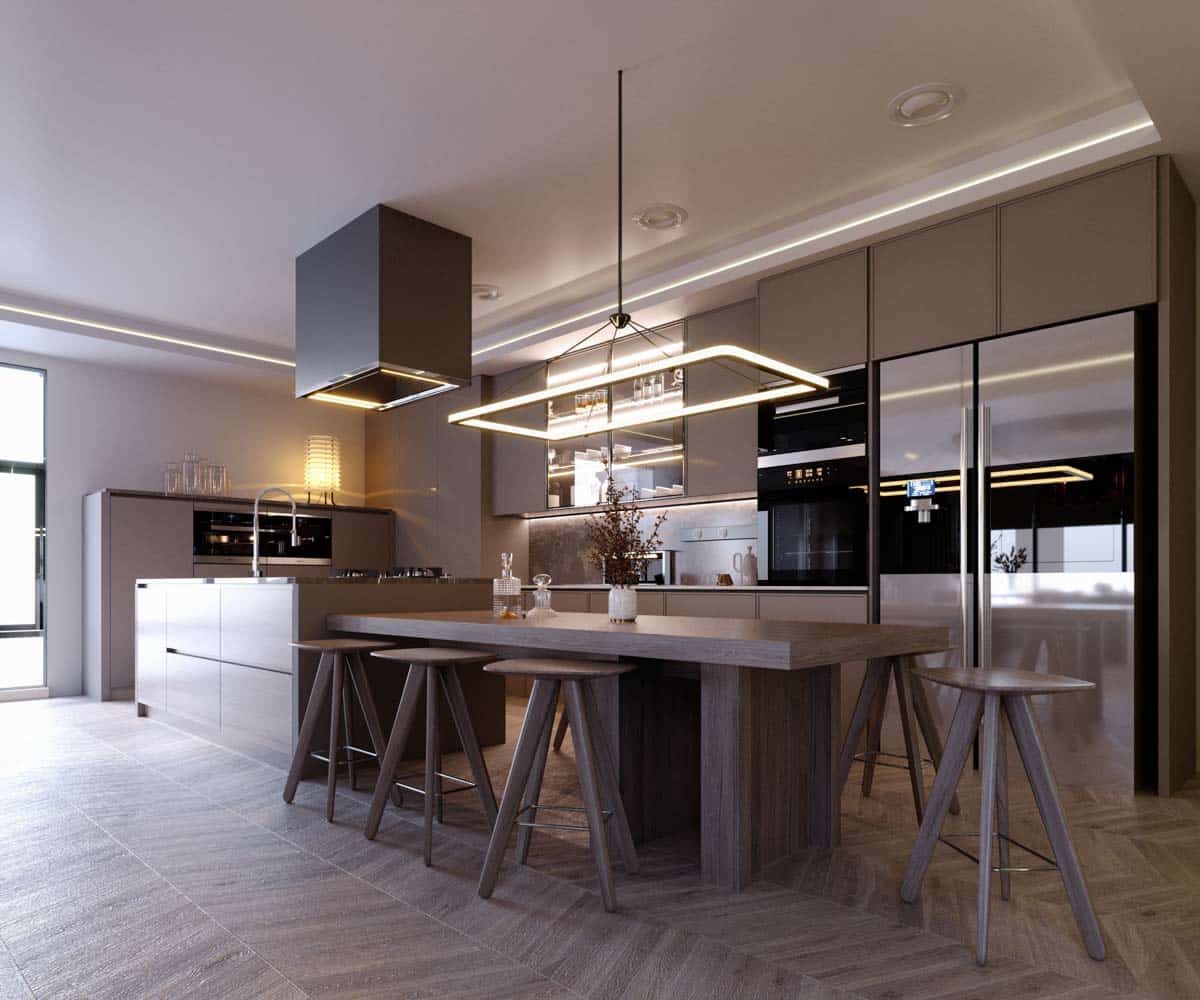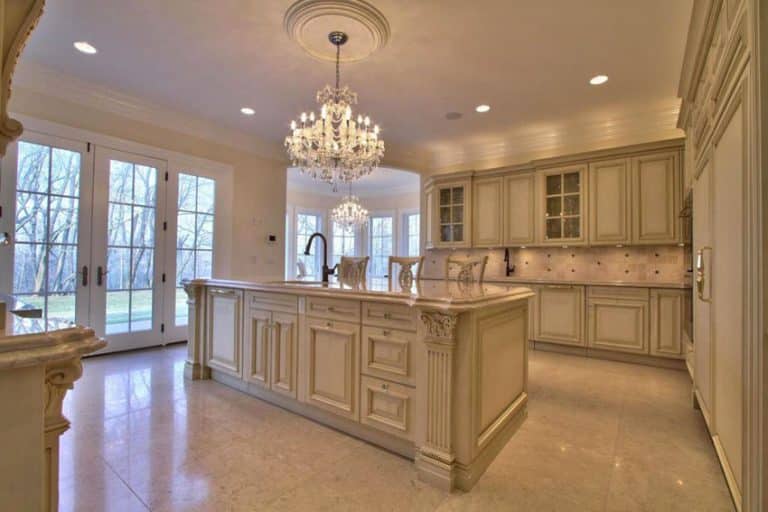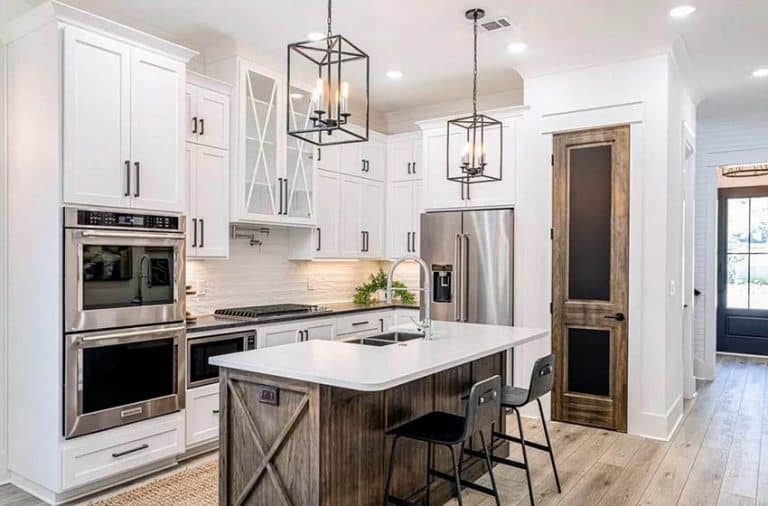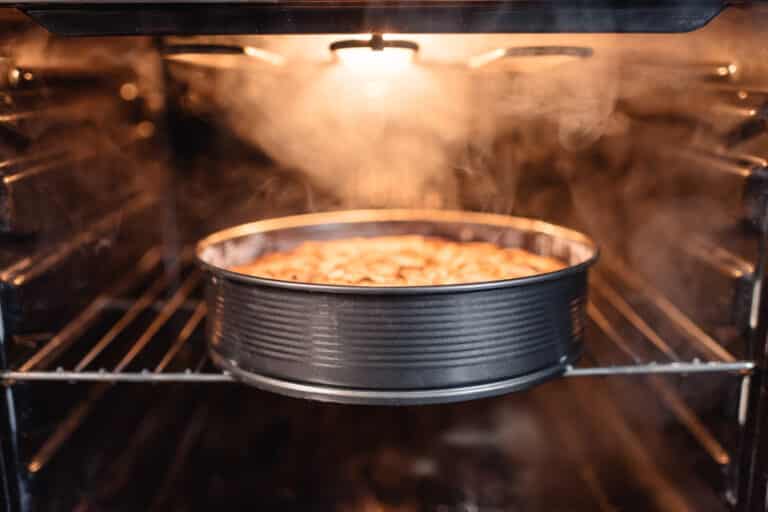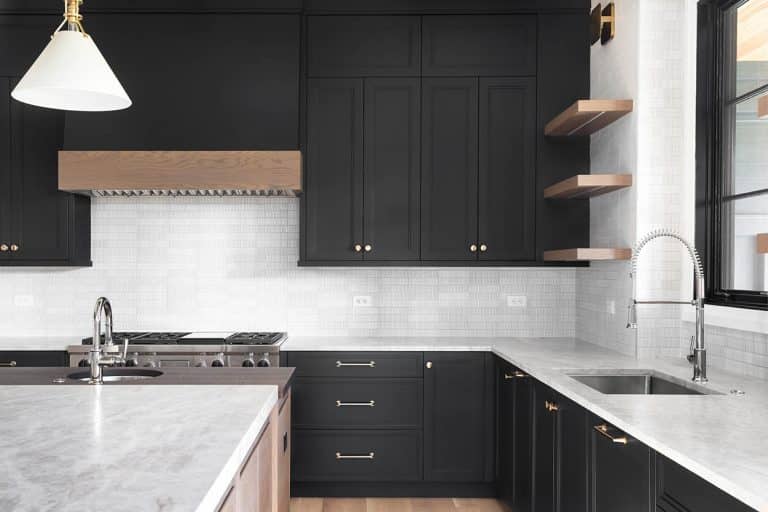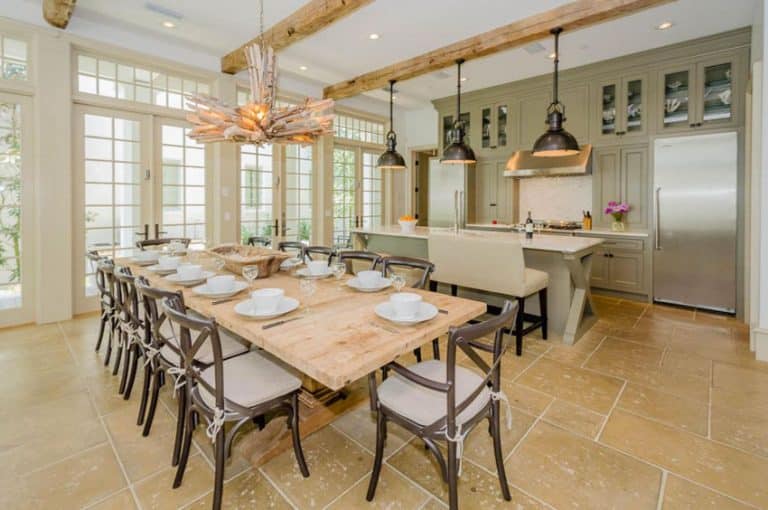19 Types of Kitchen Flooring (Best Design Ideas)
Kitchens are one of the most remodeled places in the home. Of all the home improvements one can make a modest kitchen remodel can return the most amount of money when you go on to sell the home. In fact, for many home buyers, a remodeled kitchen will either make or break their buying decision. One of the ways you can refresh a kitchen without breaking the bank is through the type of kitchen flooring you install.
Kitchens are a popular space for gathering and eating. The kitchen will get a lot of foot traffic, seeing as it is a room everyone in the family will visit at least once a day, if not many times throughout the day. This means that the type chosen is extremely important not only visually and textually but also from a sustainability and durability standpoint.
Quicklook: Different types of flooring for kitchens
• Tile (Ceramic, Porcelain, Granite, Marble, Travertine & Slate)
• Wood (Hardwood and Engineered)
• Linoleum
• Vinyl
• Cork
• Concrete
• Epoxy
• Laminate
• Luxury Vinyl
• Rubber
• Marmoleum
• Bamboo
Kitchen Floor Options
When it comes to kitchen flooring, each setting will have its own needs and wants. Considering what sorts of people will be using the area and the amount of use the kitchen will receive are factors to consider.
Kitchens may also contain a lot of moisture, which is a key issue that needs to be addressed when selecting flooring in any room, especially a kitchen.
Note that there is no a “best flooring” each material will have pros and cons. Some of the different options and their pros and cons, are as follows.
Tile Flooring
While you thought you were narrowing down the options when you chose to go with floor tile, there are still numerous choices to use.
As one of the more sought-after products for kitchen floors, they made it fit in with pretty much any design and style. Some of the option of tiles are below, but keep in mind if you are looking for something in particular, there are MANY MANY more!
Ceramic Tile
Ceramic tiles are one of the most commonly used when it comes to types of kitchen floors. As mentioned previously one of the key things we were looking for was durability, and this is where ceramic tiles really shine!
Ceramic tiles will not typically break even when plates, glass cups, pots, or other common kitchen items are dropped. Note that I did state that it typically will not break, there is always a chance that it will chip or break.
Ceramic is usually chosen for its good looks and if that is ruined by a large chip or crack, lucky us it will be any easy fix. With ceramic tiles you will only need to replace the broken tile, instead of redoing the entire floor.
Another thing previously mentioned was that the kitchen often has water and moisture. There is an option for glazing on the ceramic tiles which will offer a great deal of resistance to the moisture the tiles will experience in the kitchen setting.
There are a massive assortment of ceramic tile styles available for kitchen flooring. You can find tiles that have a contemporary, traditional or rustic design to get the exact look you’re after.
Even wood look ceramic tiles can give you the style of hardwood without all of the required maintenance issues associated with real wood. This can be perfect for an open concept design such as a kitchen that flows into a dining room for a stylish aesthetic.
Ceramic tiles are extremely water resistant, making them a strong contender for interior spaces such as the kitchen, dining room, living room or bathroom.
While the list of pros is massive for kitchen floor tiles and extremely important in this particular use, there are a few cons when it comes to ceramic tiles.
Ceramic tiles are hard and heavy. This is expected with the durability it had but will mean that they are not extremely comfortable to stand on for long periods of times. This can be combated with soft mats meant to put less stress on the body while standing on hard surfaces.
As for the weight, this is only really a problem if the kitchen is not on the lower story. In most cases this is not the case, so should not cause concern unless you have an upper story kitchen, and in that case you must make sure the structure can support that sort of weight.
Porcelain Tile Flooring
If the ceramic tiles blew you away, wait until I tell you about what we have got up next. Porcelain tile are like switching to that expensive speaker that you thought wouldn’t make a difference, but really was the best thing you have ever bought.
Porcelain tiles take the durability factor and own it. These tiles are so durable that they are commonly used in commercial settings, meaning for your home there will be no worries.
Not only is that a huge pro, but there is a Porcelain Tile Certification Agency that will make sure that all the porcelain tiles have a .5% absorption rate. Source: PTCA
All of these attributes can make for an exceedingly long life of the product. Typically if you want a floor to last decades you will have to put a lot of maintenance into it over time, but porcelain really only needs some sweeping and light mopping on occasion.
Unfortunately, every good thing has a downside. Similar to ceramic, porcelain will be extremely heavy. This again means that it is not recommended for upper story applications and is commonly not able to be done without professional installation.
Porcelain will be more expensive than ceramic tiles, and due to the weight, the installation will cost quite a bit as well.
Some tiles are Natural Stone which will make them extremely unique as well as typically environmentally friendly. Some of the more popular options are as follows:
Travertine
Travertine has recently become one of the more popular types of kitchen flooring. This is due to the natural elements that give a rustic and subtle vibe, not overwhelming the space, and being earthy tones that are easy to pair.
Travertine is a limestone material that will most typically come in beige, brown, tan, and other natural colors.
This material is considered high end due to the natural quality that makes each piece of tile unique in patterns and grains. As a high end material it is long lasting, potentially lifelong, if properly maintained. Unfortunately, the maintenance is not just a sweep and mop.
To properly take care of travertine it will need to be sealed regularly to avoid any moisture getting into the flooring, especially in a setting like the kitchen where spills and drips are prevalent.
Travertine will be used in its natural stone form which will mean it is completely recyclable and biodegradable, making it extremely eco friendly.
Granite
Granite is a luxurious material that will give a grand look to a kitchen. The sophistication levels of this material are through the roof and there are so many options when involving granite.
Granite typically had a natural pattern, but can vary in colors as well as can be brightened with polish. Now just because something pretty does not mean it can perform, but in granite’s case it is the best of both worlds.
Granite will hold up to impact and is durable for the regular traffic of a heavily used kitchen. Not only is it beautiful and durable, but it also is stain resistant.
All good things must come to an end though, the downsides to granite are the expense of the flooring and the slipperiness, especially when polished. Things like rugs and applying less polish can help combat those troubles.
Marble
Marble and granite are like sisters, they share a lot of the same qualities. Marble flooring provides elegance and sophistication a homes, being a staple of luxury a while still being able to perform.
Marble is waterproof, but like granite, can become extremely slippery. Marble, like granite, it available in numerous colors and will brighten with polish. Maintaining marble will be important, which includes resealing it periodically.
Slate
Slate is one of the types of kitchen flooring that’s an extremely unique option because every single installation is vastly different. This and other things make it a high end material, similar to the previously mentioned travertine.
This will greatly increase value when placing it in a home, unfortunately, this will make the price of the material high, but you can make it back when you sell the home!
The price really matches the quality of the product though; slate is resistant to staining and water damage, which is extremely important in a kitchen. Not only that but it also is highly durable and does not often chip, scratch or crack.
If slate is taken care of it is another material that could potentially last a lifetime. When considering any natural stone in a home it is always good to think about the installation process, and in the cases of natural stone, it is one left to the professionals due to the weight and intricate placings.
Again note that while tiles are excellent choices for flooring, it may or may not be the right choice for you and your space.
Wood Flooring
Wood is another category of flooring that will bring a much different feeling to the space than the previously discussed tiles. Wood offers a warmer atmosphere and includes numerous different choices for looks and styles.
Some of the options are below but know that in each category each has their own line of colors and patterns to select from.
Wood is sensitive to wet environments such as those found in the kitchen and may need immediate attention with any spills or messes. You can read more about the pros and cons of hardwood flooring in the kitchen here.
Hardwood Flooring
A classic, timeless addition to any room, hardwood will be an ever-present feature in homes. There are a large variety of types of hardwood species (which will reflect in the color, knotting and textures of the wood) to choose from.
Hardwood is often used in an open plan where it will span throughout the entirety of the level to create a uniform look. Hardwood is relatively hard, therefore standing for long periods may become uncomfortable, which is why rugs are commonly used to soften it up a bit.
Hardwood is also long lasting (even lifelong) , if taken care of properly. This option does take some maintenance and can be sanded down and refinished.
Engineered Hardwood
Engineered Hardwood has many pros, including its rising popularity. Durability is one of the key elements needed in kitchen flooring and Engineered Hardwood will put the money where its mouth is.
Not only will it be able to take the constant traffic but it will also be able to withstand the spills that will inevitably find you in some way, shape, or form.
Typically hardwood types are not used in kitchens due to the moisture and heat that causes hardwood to decrease drastically in longevity and potentially damage it. Now, with engineered hardwood, there is the opportunity to have a unique look while still maintaining a non-warped flooring.
The cons, however, are ever present. Due to the great durability and resistances created in the product, it is on the higher end when it comes to pricing, but you get what you paid for.
In some circumstances, it will become damaged, and it is a touch process to replace a singular plank versus the entire flooring. Additionally, as a man-made product it does contain resins and adhesives that are less than great for the environment.
Bamboo Flooring
Though bamboo is most typically place in the category of ‘wood” it is actually not even wood at all, it is a grass that is pressed and processed to get the type you see today, that highly resembles the look of hardwood.
The process of creating the bamboo flooring will give it a striped look, often showing ‘knuckles’ where the ends meet, this gives the character, often as with regular wood they have knots.
Bamboo naturally is light in color which means that the floor will be light, but if you wish for the surface to be darkened it can be carbonized which will make it softer and darker.
Initially one will think that bamboo is a sustainable and eco friendly material, and while yes it is fast growing and rapidly renewing, it also can only be made overseas.
This will mean not only does that material need to be shipped across that world, but also the procedure that’s may go on are not as regulated. To combat that fear, looking for companies that are certified by the Forestry Stewardship Council will ensure safe manufacturing methods.
Bamboo has a lot of good qualities, it is extremely durable, has a contemporary look, is easy to clean and can be refinished. Unfortunately with all the pros there are cons. Good bamboo is high in cost, for this you will pay for the quality.
If it is inexpensive make sure the manufacturer is reputable and that it meets all your needs, otherwise spending the extra dollars will be worth it in the long run.
Another thing to note is that bamboo is susceptible to water and humidity damage, in a kitchen this is an important factor.
Again note that while wood planks are very good choices for kitchens, it may or may not be the right choice for you and your kitchen space. There are still other options besides tile and wood.
Laminate Flooring
Considered to be one of the most hardworking flooring materials, Laminate flooring comes with a lot of benefits. Its durability comes from its structure which consists of a plastic-coated top layer backed by several other layers of compressed plywood and fibers. Laminate flooring comes in tile and plank form and can be installed over existing kitchen flooring using adhesive or nails.
Laminate flooring is extremely durable and can withstand daily wear and tear. It is more stable compared to other kitchen flooring and is resistant to staining and fading. On the average, laminate kitchen flooring has a lifespan of 10 to 15 years but with proper care and installation, it can last for up to 30 years.
When it comes to maintenance, laminate flooring requires minimal effort to keep it looking good. You only need a mop and broom to clean it regularly. To top it all off, it is easy to install and is one of the best materials to use for DIY flooring.
Laminate can look like real wood or even other materials like stone, tile or concrete and can also come in a variety of colors and patterns. What makes it really unique is that it mimics the graining pattern of different wood species. It is available in different finishes like matte and glossy.
Cost wise, laminate flooring is very affordable and fits kitchen renovation projects that follow a strict budget. It can run anywhere from $1 to $3 per square foot for the regular kind. Premium designer quality laminate kitchen flooring is more expensive at $10 to $12 per square foot. For installation, expect to pay an additional $5 per square foot.
However, laminate flooring comes with a few drawbacks including susceptibility to water damage. It also does not add long term value to your home unlike natural stone or hardwood flooring.
Luxury Vinyl Flooring
Luxury vinyl flooring, as its name suggests, is a more premium kind of vinyl flooring. It is of higher quality because of the multiple layers of materials that give it more durability.
Compared to laminate and vinyl flooring, luxury vinyl flooring features a more lifelike texture comparable to stone, concrete and hardwood. In short, luxury vinyl flooring allows you to replicate the look of natural materials but eliminates the impurities that come with it.
Luxury vinyl flooring consists of three layers. The bottom layer or the backing supports the whole material. The mid layer or the print design layer contains the textured realistic design, while the last layer is the topcoat which gives the material maximum durability.
Luxury vinyl flooring comes in two forms: (1) luxury vinyl tile or LVT and (2) luxury vinyl planks or LVP. These materials are manufactured the same way and have the same parts. In summary, they offer the same benefits and have the same lifespan.
Luxury Vinyl Tile (LVT) is a form of luxury vinyl flooring that comes in traditional tile squares. It typically looks like natural stone or concrete but is made of different thin layers of pvc resins, plasticizers and pigments. It comes with the practicality of a tile and offers several benefits like durability, sustainability and affordability.
Luxury Vinyl Planks (LVP), on the other hand, is the same as luxury vinyl tiles but is in rectangular form or plank shape. Like LVT, LVP is also an excellent material for kitchen flooring and offers the same advantages. Luxury vinyl planks offer the look of natural hardwood floors with embossed woodgrains.
One of the main advantages that luxury vinyl flooring offers is extreme durability. Because of its material composition, luxury vinyl flooring can withstand different forms of wear and tear which make it a reliable flooring for kitchens.
It is stain and scuff resistant and has a non-porous surface, which means it won’t get easily damaged from spilled liquids. Maintenance is also hassle free since it can be cleaned using simple tools.
Another benefit of luxury vinyl flooring is its realistic designs. This kitchen flooring material comes in a wide range of options which range from solid colors to embossed wood grains and stone textures.
Luxury vinyl flooring is also DIY friendly and a perfect choice if you want to update the look of your kitchen quickly. It works as a great substitute for natural wood and stone flooring because it is cheaper but has the same beauty. Overall, luxury vinyl planks and tiles have a lifespan of 25 to 30 years when installed correctly and maintained properly.
The only disadvantage that luxury vinyl flooring has is that it cannot be refurbished or resanded to make it look better. If you want to update it, the only solution is to change it.
Expect to pay between $1 to $12 per square foot for the tile or planks only. The price will depend on the thickness, finish and color. For the installation, you’ll need to add around $1 to $3 per square foot.
Rubber Flooring
More commonly used in commercial applications, rubber flooring is another material that makes an ideal choice for kitchens because of its strength and resilience. Rubber flooring typically comes in two forms namely rubber tiles and rubber mats or rubber sheets. Their properties are the same, but they serve different purposes.
Rubber tile flooring comes in square shape but can be custom cut into different sizes to fit a space. It comes in different thicknesses, with 8 millimeters being the most common. Rubber tile flooring has an interlocking design and is more commonly used in play areas, gyms, children’s rooms, day care centers and nurseries. This type of rubber flooring is not commonly used for kitchens.
Rubber mats or rubber floor rolls come in sheet form with a standard size of four feet wide and fifteen to fifty feet in length. Because of its large size, rubber sheets have a more seamless appearance and create a more permanent flooring option compared to rubber tiles. This type of flooring continues to be one of the most popularly rising options for kitchen applications.
Rubber flooring comes with a lot of advantages which make them suitable for kitchen use. First, it is resistant to grease and oil, which also makes it non slippery. Dirt and spills can be easily wiped with a cloth and does not require any special tools or cleaning agents. It is resilient to heavy traffic and can withstand daily wear and tear, making it one of the most reliable materials for kitchen flooring.
When it comes to aesthetics, rubber flooring has a unique appeal. It is naturally glossy and is available in numerous styles and a wide array of colors which can fit a lot of kitchen designs. From solid colors to flecked designs, rubber flooring offers a one of a kind look for homes.
You can buy rubber flooring at a price of $10 per square foot according to HomeAdvisor.com.
There is however one disadvantage that comes with rubber flooring. Because the tile forms have seams, the connections can be susceptible to moisture. But the rolled sheets have greater resistance.
Marmoleum Flooring
Marmoleum, also known as linoleum, is a type of floor covering made from natural raw materials like resins, wood flour, linseed oil, limestone and jute. Among all materials for flooring, marmoleum flooring is the most sustainable and environmentally friendly choice.Marmoleum or linoleum floors are available in sheet, tile or click plank style form.
Despite not having any synthetic components like PVC, plastic or polyolefin, marmoleum flooring is tough and has a lifespan of up to 50 years. It is easy to clean, repair and inexpensive too — making it one of the most affordable kitchen flooring materials in the market. In fact, it only costs around $3 to $7 per square foot according to Angi.com.
And since it is 100% natural, marmoleum kitchen flooring does not contain VOCs and will not release toxins. It is perfect for homeowners with allergies and asthma. Additionally, marmoleum is completely biodegradable and the linseed oil it contains inhibits the growth of bacteria.
Like other flooring, marmoleum has its own weaknesses like staining easily. However, these downsides can be minimized by wiping spilled liquids as soon as possible. You can also add protective pads on furniture to prevent scratches and make sure to use the right type of cleaner to maintain it.
Other Types of Materials
While trying to put everything into categories sometimes there are outliers that are still important to mention. If wood or tiles are not the look or feel for you there are massive amounts of other types you can choose from.
Sometimes picking outside the box will lead to a unique and inspiring finish that will soon become the next biggest thing. Some (but not nearly all) of the other types that are popular or commonly used are as follow.
Linoleum
Linoleum is a good choice when keeping the environment in mind. This material is made without and VOC’s (Volatile Organic Compound), and it is made from renewable resources. Not only is this an eco friendly flooring, but it also had a good durability, withstanding a good amount of foot traffic.
Due to linoleum’s composition, it allows it to be made in a large variety of patterns and colors, making it easy to place in most settings, and the color is all the way through the product, not just the top layer.
In addition to its array of colors and patterns, it also comes in different forms, such as sheets, tiles, or squares. This can make for some exciting and inspired designs without too much restriction. While this will be a moisture-resistant material, it can be stained and potentially scratched. This can be combated with protective coatings.
Linoleum can be a very inexpensive option for the price conscious. You can see more ideas for kitchen floors on a budget here.
Vinyl Flooring
While vinyl is category in itself, we will focus on luxury vinyl and resilient vinyl since those are the most common used.
Vinyl is extremely cost-effective, but that does mean that it does not add a grand value to the home (Once again you get what you pay for). For being as cost effective as it is it has almost limitless options!
Colors, patterns, pictures, anything you can think of can probably be printed on vinyl, you can even get something that will look like stone or hardwood (and people typically do).
Vinyl is extremely water resistant, and in some cases water proof. In addition, vinyl is extremely durable, if maintained properly it could last up to 20 years, and to maintain it there is not too much effort required.
One of the biggest downside to vinyl flooring will be that it is not eco friendly, in fact it contains PVC and lets off volatile organic compounds, which if there is a fire, will release extremely toxic chemicals.
Currently, manufacturers are working on finding a solution to this problem, and some (more expensive options) offer PVC free vinyl which a lot of commercial places will use.
Cork Flooring
When looking for a beautiful, unique option that is easy for cleaning, cork is a great choice. Cork is one of the most eco friendly and sustainable types out there. In contrast to most some options, cork is extremely soft to stand and walk on.
Other things that are important for kitchens are moisture and slip resistance. Both of these factors are incorporated when it comes to cork.
Unfortunately, due to the structure of cork it is a material that must be refinished about every four years. Since it is soft to stand on it is also susceptible to indents or damaging when it comes to heavy furniture, appliances or other large items.
Cork flooring is on the soft end of the hard-soft continuum. Soft underfoot, sound deadening, nonallergenic, and long lasting, cork is the ultimate “green” building material. – Renovation, Michael W. Litchfield
A careful consideration for cork floors are that they are best in an area without too much sunlight, which unfortunately is not typically the kitchen, this is because getting too much sun will cause the cork to become discolored, typically unevenly.
Concrete Flooring
Cement and concrete are often confused. Cement is an ingredient of concrete which is why in this case we will have a concrete. In some cases you will have a straight concrete surface, other times (more expensively I might add) you can try concrete tiles.
Concrete is a low-maintenance, highly durable product. It used to be that concrete surface was just a gray slab that was in the garage, but now some techniques can add color and design that can turn it into a unique option for a kitchen, or really any space imaginable. Concrete surfaces can also allow you to add the element of heated floors.
Unfortunately, though concrete will be hard on people walking on it too much if used in a kitchen, it is recommended to get a cushioned mat for heavily stood-in areas such as the sink to take some wear of the feet and legs.
Cracks will happen with concrete because it is a large stab of material and will need to expand and contract with the changes in the environment. Its important to use a high quality sealer product to prevent water damage and promote longevity.
Epoxy Flooring
Epoxy is an affordable option, this means that it is not the most beautiful, but it will fit in almost any budget and has some winning characteristics.
Luckily enough epoxy is quite resistant to pretty much anything you can think of: bleach, gas, cleaners, oils, chemicals, germs, and bacteria. This is why this type is used in places like garages and hospitals.
The Durability of epoxy is also astounding; concrete is the only material that will last longer than epoxy flooring, which goes underneath the epoxy anyways.
Epoxy flooring will be like adding armor to a porcupine, making it pretty difficult to destroy. Epoxy will protect form any moisture and stains and will not require any grout for any moisture to protrude into.
Epoxy will last for decades if properly installed and cared for. Unfortunately, epoxy flooring is typically a temporary solution; cracks, chipping and everyday use will make the flooring need another coat of the epoxy.
Also, applying the epoxy is not pleasant; the install will create strong fumes, require a lot of tedious preparation, must be done exactly right, and is even worse to remove if there are ever design changes.
This means that you will need professional installation at the beginning and removal after it is time to make a change. This type of flooring will not make much of an impact to the resale value of the home!
Best Flooring for Kitchen
The best kitchen flooring will be different for every project in every home. Based on your budgets, needs, time constraints, beliefs, and styles, one of the mentioned flooring will be the best for you!
All those listed are high contenders and will be great for use in the kitchen area, but check the cons listed and any ways you can work with those to make for the perfect flooring.
Also notice the other types of flooring in the home, if you have all wood flooring throughout the house, it may seem smart to stick with that and carry it through, or maybe you are looking for a change and to spice things up! Whatever your reasoning there will be flooring options.
Tile is the most popular and one of the best kitchen flooring options. Not to say it is the best, but it holds up extremely well in the kitchen setting while giving the grand, inviting look that most people are looking for in their kitchen.
Kitchens are often one of the most redone rooms, and they tend to have the most money spent on them because it is the place you want to show off, the place where everyone gathers.
This being said, though tile is on the more expensive side of things, it really does pay off in the long run and is one of the best types of kitchen flooring overall.
Best Place to Buy Flooring Online
Now that it has been decided (or at least narrowed down) the types of kitchen flooring you are looking for, the next step will be where to get it! When you google ‘where to buy flooring,’ you will most likely create a million ads.
The best place to start will be large home improvement stores, preferably one that you have nearby your home. This will allow you to stop in and find color samples or even pick up the supplies to save money on shipping.
Lowes, The Home Depot, Menards, etc.. Are all good places to begin. If you can not find what you are looking for there, then other suggested web stores that tend to be a little more specialized would be Lumber Liquidators or Floor & Décor.
Obviously Lumber Liquidators will sell primarily wood products, and Floor & Décor will focus on flooring. Amazon or Wayfair are also online retailers that can offer plenty of competitive prices and sales.
Tips for Choosing Floors
Every kitchen floor should have the following qualities:
Moisture resistance: Kitchens are prone to moisture and spilled liquids, so make sure to choose a material that won’t get damaged easily from water, oil and also acidic substances.
Slip resistance – Safety should also be included in your priority. Your kitchen floor must not be slippery to prevent accidents.
Antimicrobial or hygienic – Do not choose flooring materials that will harbor the groth of molds and mildews. Sanitation is another primary consideration because food is being prepared and, in this area, and they should not be contaminated.
Durability: Kitchen floors should be able to withstand a lot of wear and tear. It must stand up well not only to moisture but also to heat.
Easy to maintain: Kitchens are prone to messes, so your flooring must be easy to clean and sanitize.
Three Methods of Installing Floors
There are three methods of installing floors namely: glue down, floating and nail down. Choosing which floor installation method depends on the type of material used –the subfloor material and whether it is installed above or below grade.
Grade refers to the level of the house the floor is located. The ground floor is often referred to as the on grade, the second floor is above grade, and the basement is below grade. Below is a closer look on each type of kitchen floor installation method:
Glue Down Floors: Glue down floors makes use of a method that involves using adhesives to stick the flooring material to a wood or cement subfloor. This is typically used for engineered wood in kitchen and is suitable for all grade levels.
The main benefits of glue down floors are that it shifts less and can be used in surfaces that are not as leveled. Because of the way it is installed, there is less noise when walking on it. It also does not require a vapor barrier because the glue itself acts as a barrier. Thus, translating to reduced installation costs.
The disadvantages for glue down floors is higher labor costs. Another downside is that it can be more difficult to remove if you decide to replace it because they are completely adhered to the floor using strong adhesives.
Floating Floors: Floating floors, as its name suggests, uses an installation method in which the material is “floated” above a cement subfloor. It is good for all grades and is commonly employed for engineered wood flooring.
The flooring is interlocked using a “tongue and groove” connection at the end joints. The tongue is simply slid into the grooves then placed directly over the subfloor. They are simple and fast to install. It is also more stable and offers excellent strength.
Floating floors are very durable and are designed to “move” with changing humidity levels, so they contract and expand naturally without being damaged. This is the best option if you want a kitchen flooring material that can be installed quickly and easily.
Nail Down Floors: Nail down floors use the most common installation method which involves nailing the floor directly to a wood subfloor. The flooring is blind nailed through the tongue which results in them being invisible. It is typically used for solid and engineered flooring materials and for on grade and above grade levels.
Nail down floors have a few advantages, including being the most cost effective and the fastest installation. It is also easy to replace — in case one floorboard gets damaged, you can easily take it out without affecting the rest of the floor. A disadvantage to nail down floors is that the metal nails can loosen over time.
Pet-Friendly Floors
When choosing flooring materials that are suitable for pets, you must consider durability, scratch resistance, ease of maintenance and the ability to withstand accidents over time. Below are some of the best pet friend floors you can try out for your home:
• Porcelain or Ceramic Tile: Tile is one of the most suitable flooring materials for pet owners because of its extreme durability. Porcelain or ceramic tile can withstand spills and is non sensitive to moisture. It offers plenty of traction for pets and won’t get damaged from pet scratches.
• Cork flooring: Cork flooring is naturally resistant to mold and mildew and won’t get easily damaged from moisture. In case of your pet’s leaving behind messes, you can easily clean it to prevent damage. Since it is soft, it provides cushion and great traction for pets. It also reduces noise, so you do not have to worry about your pets running around.
• Luxury Vinyl Flooring: Luxury vinyl floors make an excellent choice for pets because it is durable, waterproof and cost effective. It is long lasting, scratch resistant and ideal if you want the look of hardwood floors. In addition to its resilience, luxury vinyl flooring is also easy to maintain so you do not have to worry about cleaning up after your pet’s mess.
• Laminate Flooring: Laminate flooring is best known for its ability to withstand scratches and daily wear and tear. The benefits it offers are very similar to luxury vinyl floors, except that the latter looks more realistic. In addition, laminate floors require very little maintenance and are cost effective.
• Engineered Hardwood Floors: If you want a pet friendly flooring that looks like real wood, engineered hardwood is the best material you can try. It can handle surface moisture very well and can be cleaned quickly.
• Bamboo Flooring: Another viable option for pet friendly floors is bamboo. Known for its extreme durability, bamboo flooring is stain resistant and easy to care for. It is resistant to major damages like pet scratches.
Designer Tips for Choosing Pet Friendly Floors
What to Avoid: If there are ideal flooring options for pets, there are also some materials that you should avoid like carpet and hardwood floors. Most types of carpet are not suitable for homes with pets because it is prone to staining and can easily accumulate pet hair, dander and pests like fleas Additionally, it doesn’t stand up well to moisture and requires a lot of maintenance especially if your pets pee on it.
Solid hardwood also does not make it to the list of pet friendly floors because of its sensitivity to moisture. Excessive amounts of humidity and moisture can cause it to warp. Also, hardwood floors are a bit prone to scratches, however you can look for finishes that can give your material added protection.
Before purchasing its advisable to ask questions regarding the floors construction, hardness and refinishing capabilities to determine if it can handle long-term use.
How to Fix Scratches On Floors
Scratches can be an eyesore especially if you have beautiful hardwood floors. Although they can be a bit intimidating, you can repair them using homemade solutions and some minimal effort. Below are some of the best ways to fix scratches in floors:
• Small Scratches: Small scratches can be repaired by filling in the scratch using the same color of your wood. Using some wood stain or a stain paint, apply the stain to the scratch and use a rag to blend it gently to the floor. Make sure to choose a stain that closely matches the color of your floor.
You can choose from oil-based, water-based, gel, and combination varieties of wood stains. But among these options, oil-based stains have the richest longest lasting color, but they can be difficult to apply.
• Large Scratches: There are a variety of materials you can use to repair large scratches on floors like a stain pen or a stainable wood filler. Just apply the filler on top of the scratch, make it as smooth as possible and once cry, buff the surrounding area with a sanding paper. You can put a coat of a matching stain using a rag and blend it out nicely.
• Deep Scratches and Gouges: Melted wax is a simple fix you can try for patching and mending deeper scratches. Heat the wax with a hair dryer or heat gun, when it is slightly melted, apply it on top of the scratch, then buff it using a clean, soft cloth.
Designer Tips for Fixing and Preventing Scratches on Floors
Prevention is Key: Use area rugs to give your floors added protection. You can also add protective pads on furniture legs, so they don’t leave marks on your floors when you move it. If you have pets, make sure that their nails are trimmed regularly.
Choose the right finish: Floor finishes help by adding a protective layer above your flooring material. Polyurethane is one of the most durable floor finishes for hardwood floors. If you use this finish, your floor won’t be sensitive to abrasion and scratches.
Gentle clean your hardwood floors: Unpolished and lackluster floors can highlight the appearance of scratches. Use a vacuum or mop to remove dirt, dust and hair then gently mop your floor with a homemade solution spray of water and liquid soap.
Use sandpaper to buff out scratches on floors. Fine grained sandpaper is all you need to buff out any scratches on a wood floor. Just make sure to gently sand the floor in the direction of the grain. You can apply some matching wood stain on the scratch after for a more flawless look.
Try walnuts: You’ve probably heard that walnuts work wonders in repairing scratches on wooden floor and that is a fact. The reason being is that walnuts contain natural emollients and brown dyes that can help enhance the look of scratched wood. Simply rub a walnut on the scratch in small circular motions. Let the natural oil sit on the scratch and then buff with a soft cloth.
Use common household ingredients: Sometimes, the best remedies can be found just in your pantry. You can create an effective flooring refresher using common household items like baking soda and olive oil.
Mix the two ingredients together, then apply it on top of the scratch. Let it sit for at least five minutes then buff the area gently with a soft sponge. Clean out any excess using a damp cloth and then let it dry.
For more ideas visit our other galleries of kitchen designs.

